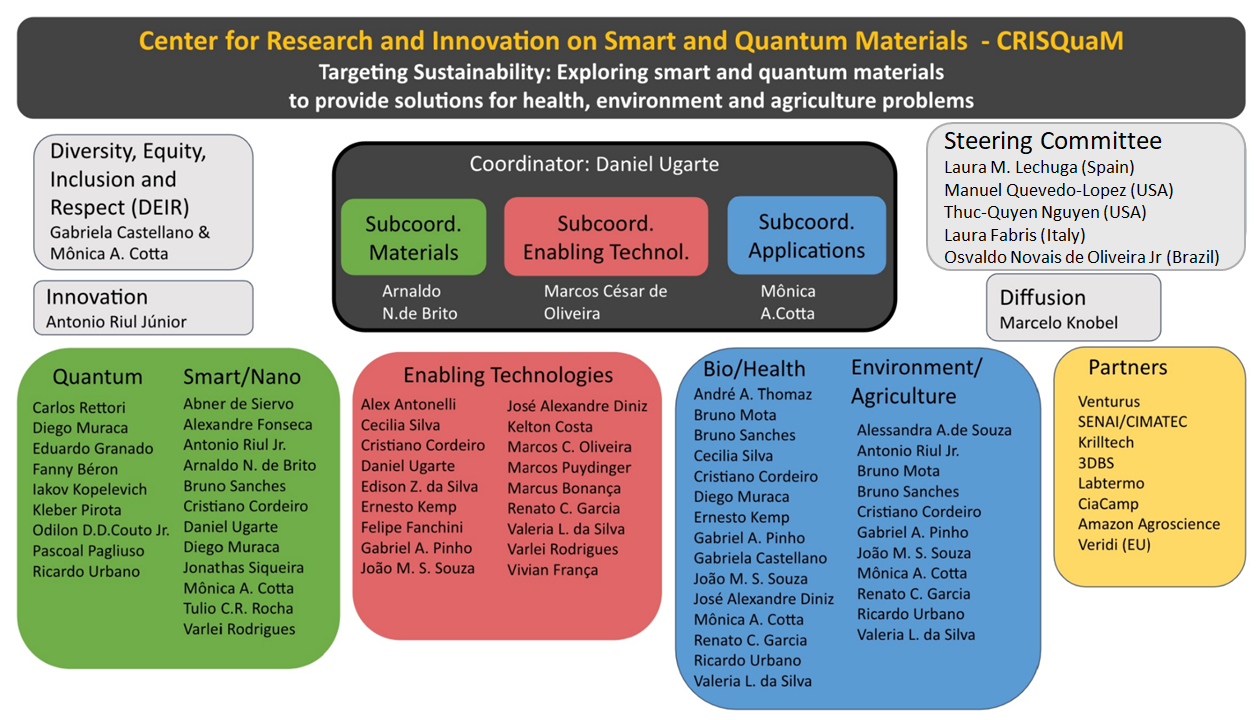BV-FAPESP: research projects supported in this Center
CRISQuaM in the Media: news about the center
CRISQuaM aims to explore the synergistic development of fundamental and applied science to create new materials with high potential for the construction of devices and sensors to address technological challenges related to sustainability, climate change, precision agriculture, ecology, and health. To achieve these goals, we have assembled an interdisciplinary and collaborative research team, integrating expertise across various scientific domains, researching novel materials with high innovation potential. By combining original synthesis methods, advanced characterization techniques, theoretical approaches, computational simulations, quantum technologies, and device construction designs, we aim to drive advances in smart and quantum materials, promoting scientific excellence and technological development. With this, we plan disruptive innovations in instrumentation—including hardware and AI-based tools—as well as in quantum technologies, biomedical devices, and signal processing, in addition to plant bionics, exploring plant-pathogen interactions. Besides research activities, we plan intensive actions in education, dissemination, and communication for the general public, as a modern society should be aware of the challenges humanity faces and how research and technology are essential for responsibly utilizing the planet's limited resources. CRISQuaM's Innovation activities are accelerated through partnerships with several companies in related technologies, many of them Brazilian. Finally, all activities of the Center are managed in accordance with diversity, equity, and inclusion goals and best practices.
The Center brings together scientists, engineers, and innovators in a collaborative effort to apply materials science and quantum technologies at the cutting edge, designing new materials and nano(bio)sensors for advanced diagnostics. The Center has a team capable of producing a wide range of (nano/micro) materials, along with precise chemical and physical characterizations using modern techniques (synchrotron, advanced microscopy, magnetotransport, magnetic resonance, optics, etc.). In addition, the team offers various options in enabling technologies, including miniaturization, processing, and additive manufacturing, as well as instrumentation, quantum sensing, and electronics development. Data analysis will employ updated approaches (numerical simulation, classical and quantum machine learning, and quantum optimization). Applications at the knowledge frontier will address urgent sustainability needs in environmental areas, precision agriculture, plant bionics, and biomedical interfaces, contributing to the development of local technologies in close partnership with the Brazilian industry.
The organization of the Center is based on three pillars — Materials, Enabling Technologies, and Applications — together with partner companies, as described in the figure below.

2024-06-12
With simple audio messages and images, the Viva Vida program produced significant improvements in over-sixties living in a major city in metropolitan São Paulo (Brazil). An article on the study is published in Nature Medicine.
2024-06-10
After 48 hours of exposure to the pesticides imidacloprid, pyraclostrobin and glyphosate, stingless bees of the species Melipona scutellaris exhibited morphological and behavioral alterations that could weaken colonies, impair pollination and adversely affect food security.
2024-06-07
For two weeks, scientists from the University of São Paulo collected specimens of poraquês and other fish of the order Gymnotiformes aboard the vessel Comandante Gomes. The Agência FAPESP report followed the work in the field.
2024-06-07
Historic drought in the Negro River basin and a possible inaccurate description of the distribution of Iracema caiana may be reasons why the species was not found by the DEGy Negro River Expedition. The episode describes the first collections.
2024-06-07
The low severity of the injury, rapid medical attention and appropriate care meant that the researcher was able to return to work on the same day he was stung by a venomous fish. In the Amazon, cases often get worse because a lack of specialized care.
2024-06-07
In preparation for the expedition down the Negro River in search of fish of the order Gymnotiformes, researchers gather more than 200 kilos of equipment and supplies for detecting, collecting and storing specimens.
2024-06-07
The last episode of the series of reports takes stock of the journey of a group of researchers from the USP Museum of Zoology, who spent two weeks traveling along the Negro, Preto and Jauaperi rivers in the states of Amazonas and Roraima.